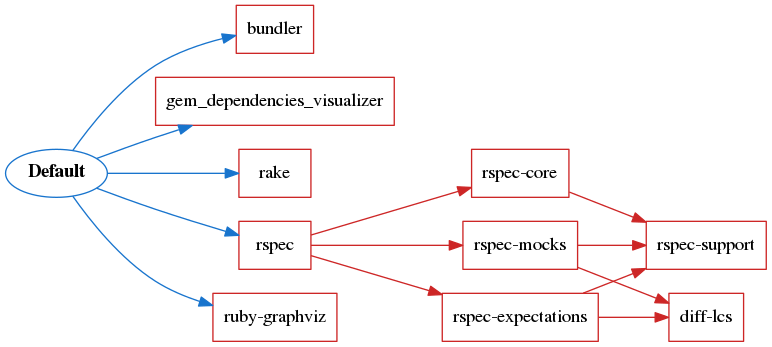Add this line to your application's Gemfile:
gem 'gem_dependencies_visualizer'And then execute:
$ bundle
Or install it yourself as:
$ gem install gem_dependencies_visualizer
To produce a graph of your gem dependencies, pass the content of a Gemfile.lock and, if available, the content of the Gemfile as is as an input to the visualizer. For gems, you can also use a different method to pass the gemspec and your Gemfile.lock content. You can (optionaly) pass a graph name you might want to give to the .png file to be produced.
To use it just run the following in your code:
GemDependenciesVisualizer.produce_gems_graph(gemfile_content, gemfile_lock_content, graph_name, options = {})
GemDependenciesVisualizer.produce_gems_graph_from_gemspec(gemspec_file_content, gemfile_lock_content, graph_name, options = {})Available options you could use are:
- :graph_direction, which will set how your graph will be produced with options ** top-bottom, for the graph to start on the top towards the bottom ** bottom-top, for the graph to start on the bottom towards the top ** right-left, for the graph to start on the left towards the right ** anything else is set to default, which is left to right.
- :keep_gem_version, which will keep the versions set in the Gemfile.lock
- :specific_directory, which will mark the folder in which the graphs should be rendered. All graphs are always created inside gem_dependencies_graphs folder. Default namespace used is app/assets/images.
For example by using the produced Gemfile.lock in this gem, we can get the following:
After checking out the repo, run bin/setup to install dependencies. Then, run rake spec to run the tests. You can also run bin/console for an interactive prompt that will allow you to experiment.
To install this gem onto your local machine, run bundle exec rake install. To release a new version, update the version number in version.rb, and then run bundle exec rake release, which will create a git tag for the version, push git commits and tags, and push the .gem file to rubygems.org.
Bug reports and pull requests are welcome on GitHub at https://github.com/arcanoid/gem_dependencies_visualizer. This project is intended to be a safe, welcoming space for collaboration, and contributors are expected to adhere to the Contributor Covenant code of conduct.
The gem is available as open source under the terms of the MIT License.

